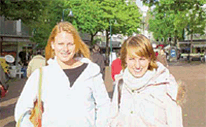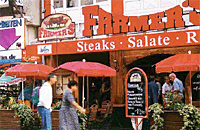Topic 2: Cultural Geography of Germany

Lesson 1: Who are the People of Germany?
Lesson Objective
The student will identify similarities and differences among the German people
Materials and Resources
 Transparency 3 - “People” |
 Transparency 4 - “Restaurants” |
- Handout 1 - “People”
- Handout 2 - “Restaurants”
Strategies
Germans do not look or act very differently from Americans. In general, Germans do not at all have blond hair and blue eyes. Beginning in the 1950s, many people from different countries came to Germany looking for jobs. Today, Germany has a mixed population coming from as far away as Turkey, Pakistan, Vietnam, and Africa. Children in Germany dress much the same as American children. Few people wear traditional costumes for special events, such as a Dirndl (a dress with a full skirt and a close-fitting bodice) or Lederhosen (leather shorts). Some customs are different. People shake hands a lot more in Germany, almost every time they meet. If people go to dinner at a friend’s house they often bring flowers or sweets for the host or hostess.To demonstrate this point of cultural diversity, have students number 1 through 12 on a sheet of notebook paper. Show students the pictures on Handout 1 and Transparency 3, “People” and ask them to decide whether the picture shows a person living in the United States (write “U.S.” on your paper) or a person living in Germany (write “G” on your paper). When students finish, tell them that all the pictures show people who live in Germany. Debrief the lesson by asking such questions as:
- What do these people have in common? (Possible
answers: They are all Germans; they all live in Germany)
- What are some differences that you can see among the people in the pictures? (Possible answers: There are differences in age, gender, race, clothing)
- What are some less visible similarities and differences among the people in these pictures? (Possible answers: People’s tastes, interests, talents and feelings may be alike or different; people may prefer certain clothes, foods, and activities; they may be good at different things; they may feel happy, sad or afraid at different times.)
- What are some differences that you can see among the people in the pictures? (Possible answers: There are differences in age, gender, race, clothing)
- Which of the photographs could have been taken
in the United States? What evidence do you have?
- Which of the photographs were obviously taken in Germany? What evidence do you have?

 Printable PDF
Printable PDF